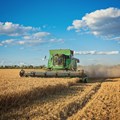Subscribe & Follow
Jobs
- Junior Farm Supervisor Potchefstroom
The role of AI in the agricultural revolution and risks of change

The next sector deserving our focus concerning AI and the hope it creates in addition to its unavoidable risks is agriculture. From a distance, agriculture may seem far removed from AI as a concept and its real-world consequences. However, the opposite is deductively true. AI’s influence over the agriculture sector is already having profound effects on global food supply and consumption, stretching into our homes and on our dinner tables.
AI investment in agriculture in the United States is projected to reach $4 bn (approximately R73bn) by 2026 and $4,7bn by (approximately R85bn) 2028. The various ways AI is applied in the agricultural sector, especially by commercial farming conglomerates and companies, illustrate how it can revolutionise global food production. Yet, every opportunity carries risk.
How AI is creating new dividends within the agriculture industry
Drones
Drones may appear as a new technology, but they were first invented in 1917 during the First World War. By definition, drones are simply remote-controlled pilotless devices, and the agriculture sector has in recent years used them to provide low-altitude imagery of crops to identify pesticide effectiveness and other visual clues of crop development.
AI is leveraging these data inputs and processing them at high speed, so farmers are no longer just relying on their own experience and knowledge but on information gathered from thousands of other farms in some cases over the years. Furthermore, drones are becoming more precise, such as planting or sowing seeds either themselves or in collaboration with human workers in ways that optimise human labour and land use.
Algorithms
Algorithms are helping farmers dictate how much water their crops should receive according to live weather conditions and the best ways to input nutrients into the soil. Historical data is fed into
AI-supported models provide commercial farmers with analysis and insights regarding the crops they should plant, at what scale, current crop market prices, and likely product per hectare. Greater efficiency improves revenue and lowers costs, enhancing operational sustainability.
ESG
Similar to the hospitality industry, the optimisations created by AI can improve farmers’ ESG ratings and reduce their carbon footprint. Improved ratings can lower the cost of borrowing from large financial institutions that are increasingly incentivised to support environmentally sustainable businesses.
Supporting global food security through efficient farming only enhances capital market attractiveness, which at its best, can create a virtuous circle.

AI risks within the agriculture sector
Data privacy and protection
The more data an organisation creates, the greater the need to correctly manage and protect it, with risk and liability accompanying growing data generation and application. These risks, and the liability they create, include cyber security threats, unauthorised data access, data breaches, and malicious attacks.
Agriculture operators rely significantly on data collection, wrangling an analysis to provide managers and decision-makers with high-quality information to drive optimised decision-making, which impacts crop yield, product and costs.
Generative AI and intellectual property protection
Commercial farmers often or exclusively use specially bred seeds as the backbone of crop production, with information concerning how best to maximise crop yield from these bespoke inputs critical. These specially bred seeds provide an interesting scenario that users of generative AI should be keenly aware of.
For example, a commercial farmer logs onto a generative AI tool inputs a prompt asking for the best available tomato seed and how to breed it and is provided with a source with the necessary information. However, it may be, that the process of creating the seed is protected by copyright law or the seed itself could be protected by way of a Plant Breeders Right.
If the farmer proceeds to create a seed produced by generative AI, the liability faced may be extensive. In the absence of an infringement, there is also the question of who rightfully owns the intellectual property (IP) produced from a formula accrued from generative AI.
The scenario described above may appear far-fetched, but the degree to which data is loaded into generative AI models with and without permission is unknown, creating substantial risks in the areas of IP law. Similar concerns exist around software development and use. If the core code for an agriculture-focused software programme is taken from generative AI, similar liability risks exist.
Lack of guidance in South African law
To avoid these scenarios, employers must update their labour and disciplinary policies to acknowledge the risks created by AI use. South African law at present provides little guidance on the use and management of AI-related content and information, placing the onus on companies and employers to take up the mantle of protecting themselves from liability.
AI provides the agriculture sector with numerous advantages, but risks are inherent. Scenario planning, preparation and sound legal advice are crucial in avoiding these pitfalls.





















